Ijraset Journal For Research in Applied Science and Engineering Technology
- Home / Ijraset
- On This Page
- Abstract
- Introduction
- Conclusion
- References
- Copyright
Quantitatively Physical and Chemical Analysis of Soil Samples of District Dhule, Maharashtra
Authors: Falguni Bhavsar, Harsh Jain, Suyog Patil, Tushar Sharma, Aryan Lad
DOI Link: https://doi.org/10.22214/ijraset.2024.65826
Certificate: View Certificate
Abstract
This study investigates the physical and chemical properties of soils from five distinct locations in Dhule District, Maharashtra. Soil samples were collected from the villages of Shewali, Shirpur, Dhandane, Phophare, and Kusumba to examine key parameters such as pH, alkalinity, conductivity, and hardness, which are crucial indicators of soil quality and fertility. The results indicate significant variations in the physicochemical properties across these locations, suggesting the influence of local environmental factors. This study provides valuable insights into soil management practices that could improve agricultural productivity and environmental sustainability in the region.
Introduction
I. INTRODUCTION
The term solum is latin word meaning and earthly materials which plants grow and develop [6].Soil is a dynamic natural resource, essential for sustaining life and agricultural productivity. Soil properties such as pH, alkalinity, electrical conductivity (EC), and hardness are key factors influencing soil fertility, plant growth, and overall ecosystem health. In Dhule District, Maharashtra, where agriculture plays a pivotal role in the economy, understanding soil composition and characteristics is vital for optimizing agricultural practices and ensuring sustainable land use.
A. How is Soil Formed?
Soil is formed by weathering of rocks. Solid rock can weather away in one of the three ways into the soil, namely:
- Mechanical Weathering: This is commonly observed near the surface of the earth. Also called physical weathering, as this process is influenced by physical forces such as wind, water and temperature.
- Chemical Weathering: As the name suggests, chemical weathering occurs when rocks are broken down by chemical reactions. Often, such types of weathering can change the chemical composition of the soil.
- Biological Weathering: Though not an actual weathering process, living organisms weaken and subsequently disintegrate rocks, often by initiating mechanical or chemical weathering. For instance, tree roots can grow into cracks in the rock, prying them apart and causing mechanical fractures. Microorganisms can secrete chemicals that can increase the rock’s susceptibility to weathering.
B. Composition of Soil
Climate, natural vegetation and rocks are the factors determined the quality of soil in a location. The soil contains 50-60% mineral, 25-35% water 5-25% air and little percentage of organic matter. The soil from the intermediate zone between the atmosphere and the rock cover of the earth is lithosphere. There are many methods for soil analysis of chemical and nutrient properties [5]
Given below is the composition of soil in detail:
1) Organic Matter
Organic substance is found in very small amounts in the soil. Plants and animals are the main sources of organic matter. Depending upon the decomposition stage, the organic matter is of the following three types:
- Completely decomposed organic matter
- Partially decomposed organic matter
- Undecomposed organic matter
2) Minerals
Minerals are an important element of the soil. These are solid components composed of atoms. These occur naturally and have a fixed chemical composition. Olivine and feldspar are the main minerals present in the soil.
3) Gaseous Components
The air-filled pores of the soil contain the gaseous components. Nitrogen and oxygen present in the pores is generally the atmospheric air fixed by the microorganisms. However, the composition of carbon dioxide is higher due to the gas produced by microorganisms present in the soil.
4) Water
The soil dissolves the minerals and nutrients in the water and transports it to different parts of the plants. These are essential for the growth and development of the plant.
The present study is based upon Physico-chemical properties of soil collected from five villages of Dhule District Shewali, Shirpur, Dhandane, Phophare, and Kusumba. The parameters selected for the study are pH, alkalinity, conductivity, and hardness. This research will help determine the extent to which localized differences in soil composition affect both agricultural productivity and sustainability as well as environmental health.
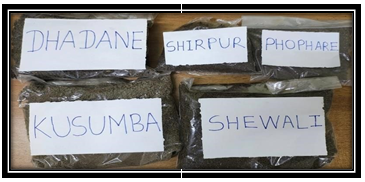
The soil characteristics studied in this project pH, alkalinity, electrical conductivity (EC), and hardness are integral to assessing soil quality and suitability for agriculture.
Here’s an overview of these parameters:
- pH: Soil pH is a measure of the hydrogen ion concentration, indicating whether the soil is acidic or alkaline. It plays a crucial role in nutrient availability, microbial activity, and overall soil health. In acidic soils, certain nutrients may become less available to plants, while alkaline soils can lead to deficiencies in micronutrients[3].
- Alkalinity: Alkalinity refers to the capacity of soil to neutralize acids. High alkalinity can hinder the absorption of essential nutrients like iron, manganese, and phosphorus. It is especially problematic in regions where irrigation with hard water is common[2].
- Electrical Conductivity (EC): EC can be expressed as a measure of the soil's ability to conduct electricity that is directly associated with the concentration of soluble salts in the soil. High EC values might indicate salinity, which may influence on plant growth and soil health[1].
- Hardness: Soil hardness refers to the compactness of soil, which influences root penetration and water infiltration. Hard soils often lead to poor root development and reduced agricultural productivity[4].
II. MATERIALS AND METHODS
A. Study Area
The research work carried out on soil samples taken from different parts of Dhule District, Maharashtra. This district comprises diverse agricultural activities, right from cotton and soybeans cultivation to horticultural practices. Soil samples representing the agricultural areas of the region were collected from five villages: Shewali, Shirpur, Dhandane, Phophare, and Kusumba.
B. Sample Collection
Soil samples were collected from each of the five villages. For each location, three sub-samples were taken from different spots within a 10-meter radius to ensure sample representativeness. The samples were carefully mixed to form a composite sample, which was then air-dried, sieved, and stored in labeled containers for further analysis.
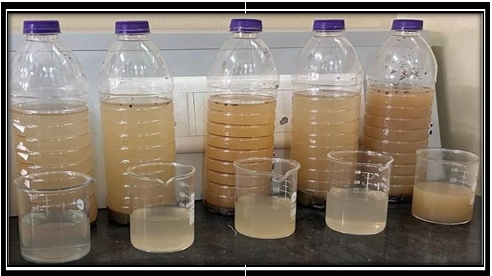
C. Parameters Tested
The following tests were conducted on the soil samples:
pH: Measured using a pH meter in a 1:1 soil-to-water suspension.
Materials required: soil-to-water suspension , pH meter , pH meter electrode , beaker .
Procedure: Take the soil-to-water suspension in a beaker and dip the pH meter [1] electrode in it and note the value of pH.
Result: Table 1. Readings of pH
|
SR NO. |
Village Name |
pH of Sample |
|
1 |
Shirpur |
8.33 |
|
2 |
Shewali |
8.35 |
|
3 |
Kusumba |
8.30 |
|
4 |
Phophare |
8.08 |
|
5 |
Dhadane |
8.02 |
Graph 1
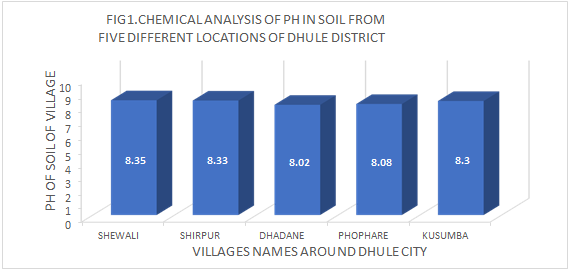
Alkalinity: Determined using the titration method with a standard acid solution.
Materials required : Burette , Pipette , Conical flask , 100ml Measuring cylinder , soil-to-water suspension , Phenolphthalein , N/50 HCl , Methyl Orange.
Procedure:
- Take 100ml of soil-to-water suspension to be tested in titration flask. To it add 2-3 drops of phenolphthalein and titrate the sample against standard N/50 HCl until the phenolphthalein end point.
- To this above same solution add 2-3 drops of methyl orange; continue the titration until the sharp colour changes from yellow to red. Note the total readings as methyl orange end point.
Result: Table 2: Readings of alkalinity
|
SR NO. |
Village Name |
Hydroxide (OH-) |
Carbonate (CO32-) |
Bicarbonate (HCO3-) |
|
1 |
Shirpur |
0 |
30 |
40 |
|
2 |
Shewali |
0 |
0 |
65 |
|
3 |
Kusumba |
0 |
10 |
100 |
|
4 |
Phophare |
0 |
0 |
55 |
|
5 |
Dhadane |
0 |
0 |
60 |
Graph 2
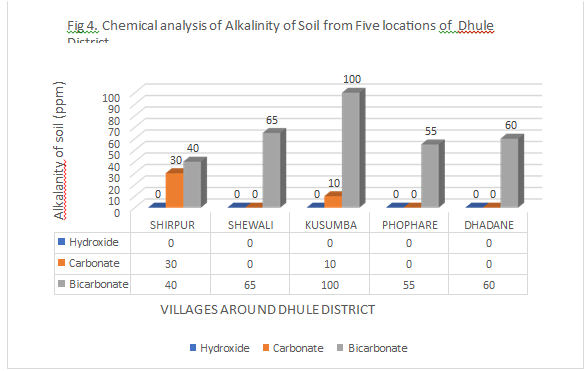
Electrical Conductivity (EC): Measured using a conductivity meter, with a 1:1 soil-to-water ratio.
Materials required : Conductivity meter , Beaker , Electrodes , soil-to-water suspension.
Procedure: Take soil-to-water suspension in beaker and dip the electrode of conductivity meter in the beaker and note the values of conductivity.
Result: Table 3. Readings of conductivity
|
SR NO. |
Village Name |
Conductance (mS) |
|
1 |
Shirpur |
182.4 |
|
2 |
Shewali |
92.80 |
|
3 |
Kusumba |
156.00 |
|
4 |
Phophare |
96.00 |
|
5 |
Dhadane |
116.50 |
Graph 3
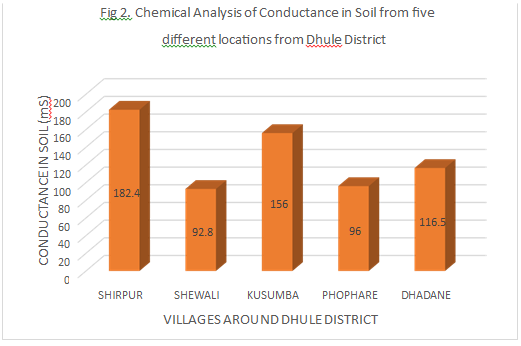
Hardness: Soil hardness determined by EDTA method .
Materials required : Burette , Pipette , Conical flask , Standard EDTA solution , Eriochrome black T , Soil to water suspension , Buffer solution of pH 10.
Procedure : Fill the burette with EDTA solution up to the mark. Take 10ml of water sample and 5ml of buffer solution of pH 10. Add 2-3 drops of EBT indicator. Titrate the solution against EDTA till the wine red colour changes to sky blue[7].
Result: Table 4. Readings of hardness
|
SR NO. |
Village Name |
Hardness (ppm) In terms of CaCO3 |
|
1 |
Shirpur |
220 |
|
2 |
Shewali |
100 |
|
3 |
Kusumba |
90 |
|
4 |
Phophare |
70 |
|
5 |
Dhadane |
80 |
Graph 4
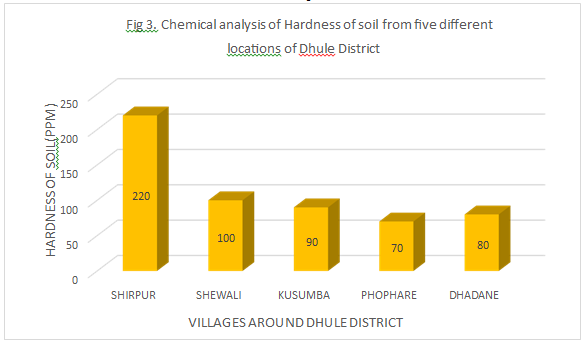
III. RESULT AND DISCUSSIONS
The results of this study demonstrate that soil properties vary significantly across different villages in Dhule District. The pH values suggest that agricultural soils are mostly neutral, making them suitable for a variety of crops. High conductivity and hardness(shirpur) in the urban areas reflect the impact of human activity on soil health. The water Hardness >180 represents very high water and Hardness <60 represents medium and 60<hardness<120 represents medium water.[7]
These findings align with previous studies, which highlight the importance of soil management in mitigating the effects of urbanization and industrialization on soil quality[2]. The variations in soil properties emphasize the need for localized soil management strategies tailored to the specific environmental and agricultural conditions of each village. As PH is very important in determing the capacity. The ph value for soil for soil if acidic then it is <6.5 , it is Normal when ph is between 6.5-7.8 and alkali >7.8[8].
|
SR NO. |
Village Name |
pH |
Alkalinity (ppm) |
Conductivity (mS) |
Hardness in terms of CaCO3 (ppm) |
|
|
Carbonate |
Bicarbonate |
|||||
|
1 |
Shirpur |
8.33 |
30 |
40 |
182.4 |
220 |
|
2 |
Shewali |
8.35 |
0 |
65 |
92.80 |
100 |
|
3 |
Kusumba |
8.30 |
10 |
100 |
156.00 |
90 |
|
4 |
Phophare |
8.08 |
0 |
55 |
96.00 |
70 |
|
5 |
Dhadane |
8.02 |
0 |
60 |
116.50 |
80 |
Conclusion
This study provides a comprehensive analysis of the physicochemical properties of soils from five villages in Dhule District, Maharashtra. The results indicate variations in Hardness and conductance. And Alkalanity has content of more bicarbonate ions in all soil and has no hydroxide ions. And hence due this calcium and magnesium ions becomes less due to formation of calcium and magnesium carbonates . And overall Ph is moderate or low alkaline up to 8. As pH ranges is from 8 to 8.5 which signifies that it is a black soil which is generally found in Northern region of Maharastra. In the town like shirpur the soil is very hard which is not good to health.
References
[1] Bohn, H. L., McNeal, B. L., & O\'Connor, G. A. (2001), Open Journal of Forestery, Soil Chemistry (3rd ed.). John Wiley & Sons, Vol.6 No.5, September 5, 2016. [2] Mishra, S., Patel, P. K., & Kumar, A. (2014). Soil alkalinity and its effect on crop growth. Agricultural Science Journal, 15(2), 45-52. [3] Raghunath, H. M. (2006). Groundwater Hydrology (2nd ed.) [4] Singh, R., Sharma, P., & Thakur, P. (2011). Soil hardness and its effects. [5] Chandak Nisha, Maiti Barnali Pathan Shabana, Desai Meena And Kamlesh Shah. Analysis of soil samples for its phsico and chemical Parameters. Newest International Referred Iournals, 2017, Vol:3 Page : 36-40. ISSN:2349-3372 [6] W.B.Shirsath , Karm .A. Patil, Kai Annasaheb N.K Patil. Quantitatively Physico-chemical Analysis of Soil samples of Satan(Baglan) Tahsil, District Nashik, Maharastra(India). Journal of Scientific Research of The Banaras Hindu University, 2021,Volume 65, Issue 7. [7] Methods Manual Soil Testing in India , Department of Agriculture and Cooperation , Ministry of Agriculture , Government of India. [8] Karande Sucheta, Gamit Sheela and Prajapati Dhaval.Analysis of Soil Samples for its physical and chemical parameters from Mehsana and Patan District. Int. Res. J of Science & Engineering, special issue A9, July 2020.
Copyright
Copyright © 2024 Falguni Bhavsar, Harsh Jain, Suyog Patil, Tushar Sharma, Aryan Lad. This is an open access article distributed under the Creative Commons Attribution License, which permits unrestricted use, distribution, and reproduction in any medium, provided the original work is properly cited.

Download Paper
Paper Id : IJRASET65826
Publish Date : 2024-12-09
ISSN : 2321-9653
Publisher Name : IJRASET
DOI Link : Click Here
 Submit Paper Online
Submit Paper Online

